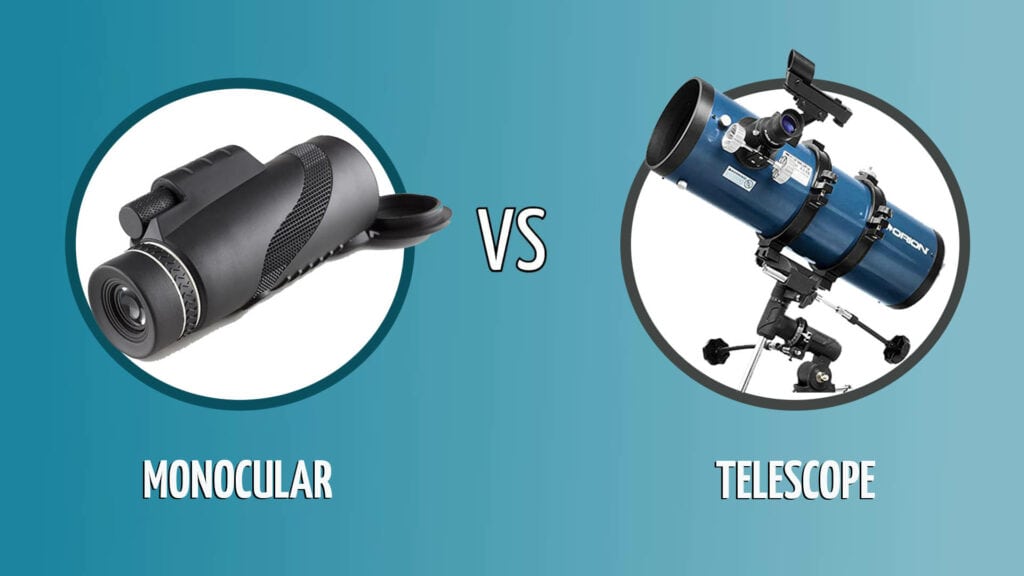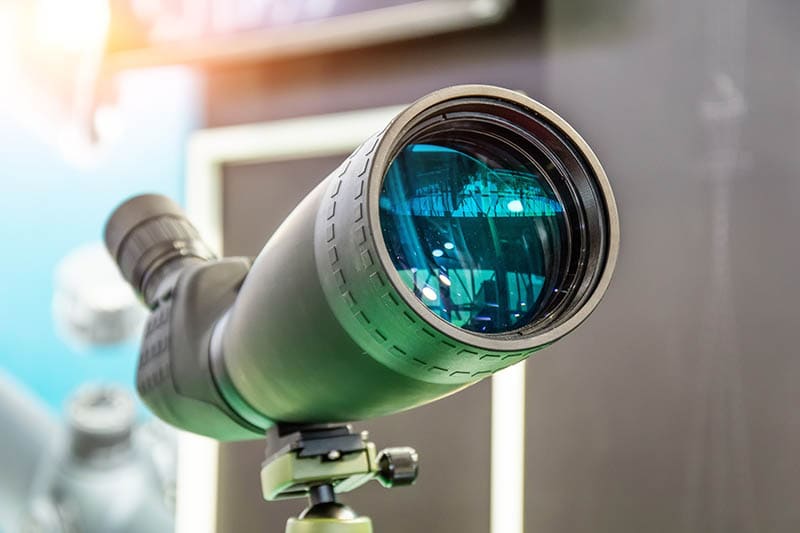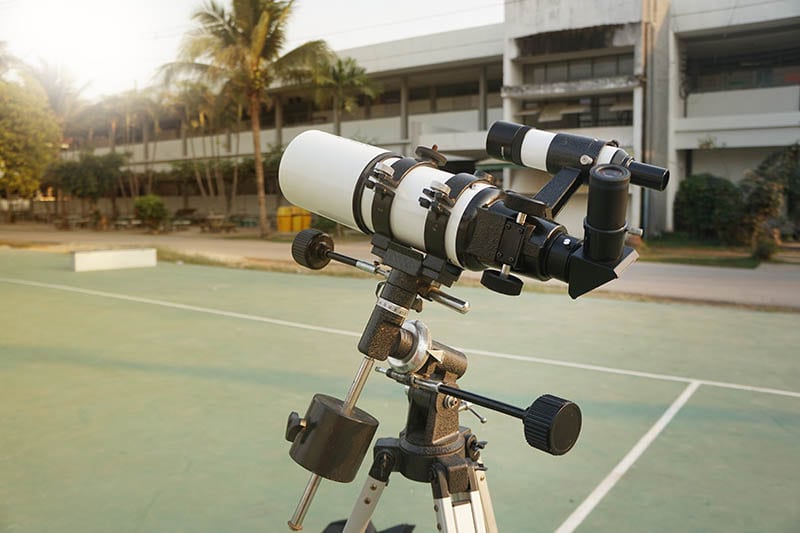Monocular vs Telescope: Differences Explained (With Pictures)
Last Updated on

In the world of magnification devices, two of the most frequently used include the telescope, an instrument that’s been around for centuries, and the more recent monocular, a telescope of a different flavor. The monocular and telescope are extremely useful in situations where seeing distant objects is necessary or helpful. They do, however, have several significant differences. The question is, which one is right for your needs? We’ve explained the differences between monoculars and telescopes below to help you make the best purchase decision.

At A Glance
- Lengthy setup time
- Relatively expensive
- Zoom: 30x to 300+x
- Field of View: Wide
- Ease of use: moderate
- No setup time – instant use
- Relatively inexpensive
- Zoom: Less than 30x
- Field of view: Narrow
- Ease of use: easy
The Monocular & Telescope Are Both Telescopes
It must be noted at the outset that monoculars are modified telescopes and use similar technology to produce a similar result, namely the magnification of distant objects. Although quite different in some ways, a telescope’s basic components and qualities are very similar to those of a monocular. They are the same device with specific modifications.

Overview of Monocular

A monocular is a single-lens, single-eyepiece magnification device that, as mentioned above, is a variation on the telescope. However, the monocular is less powerful. A monocular has advantages since it’s smaller, weighs less, costs less to manufacture, and is easier to use than a telescope. Thanks to its smaller size, it can also be used with one hand.
A monocular, like a telescope, has a single viewfinder and is used with a single eye. Because of their smaller size, monoculars can be worn around your neck with little or no fatigue. They can also be used immediately and naturally as opposed to a telescope that must be placed into position with care and precision. However, unlike a telescope, a monocular provides far less magnification and a narrower field of view.
How It Works
A monocular magnifies objects that are far away using a combination of mirrors or curved lenses. These gather the light and focus it inside the device. Some monoculars also have specialized digital, night vision, and thermal features that allow the user to see other forms of infrared light.
| Magnification: | 6x to 10x |
| Objective Lenses: | Various |
| Close Focus: | Yes |
| Eye Relief: | Yes and no |
| Field of View: | Narrow |
What is a Monocular Good for?
Monoculars can be used in a variety of ways. Because of their small size and compact, portable nature, monoculars are excellent for hikers, campers, and adventures. Hunters use monoculars to spot game quickly, and many people use monoculars at sporting events, concerts, Broadway shows, and art galleries.
A monocular is perfect anywhere you want to see something up close and with more details but want a compact magnification device that needs no setup time. However, a monocular probably won’t be your first choice if you’re looking for Saturn’s rings or taking long-distance, hi-res photographs.
- Small
- Portable
- Lightweight
- Fast usage
- Various specialized options
- Excellent situational awareness
- More affordable price range
- Field of view is smaller
- Can cause eye fatigue
- May feel unnatural to some users
- Not the best for stargazing

Overview of Telescopes

More than 400 years ago, in 1608, a man named Hans Lippershey sketched the first plans for a telescope in Holland. The telescope is a light-collecting device that uses mirrors or curved lenses to refract the light and provide a close-up view of objects in the distance.
The larger the mirrors on a telescope, the better light-collecting abilities it will have. That directly impacts how much your eye can see when looking through any telescope. For example, a 4-inch diameter telescope mirror will give you 4x the magnification of a 2-inch mirror. The bigger you go, the more light is collected and the more details you will see in the telescope’s eyepiece.
How It Works
A telescope, like a monocular, magnifies objects that are far away using a combination of mirrors or curved lenses. These gather light and focus it inside the device to provide the image you see in the eyepiece. Unlike monoculars, telescopes usually don’t have specialized features like night vision. However, they come in a larger range of mirror and lens sizes than most monoculars.
| Magnification: | 25x to 300x |
| Objective Lenses: | Various |
| Close Focus: | Yes |
| Eye Relief: | Yes and no |
| Field of View: | Wide |
What Is a Telescope Good for?
Telescopes, in many cases, are used to view the stars and planets in our solar system and beyond. However, some people use telescopes to photograph, spot birds far in the distance, look out at the sea, and do other activities. However, it’s worth noting that telescopes were designed to look at the heavens and are one of the best tools to do so. Some of the biggest in the world, including the Gran Canaries Observatory with its 34-foot primary mirror, are massive. However, the largest telescopic mirror on the planet is in the Hobby-Eberly Telescope at the McDonald Observatory in Ft. Davis, Texas. That one is just over 36 feet wide!
- Stronger magnification
- Wider field of view
- Extremely stable view of the subject
- Less fatigue thanks to the tripod
- Much higher magnification options
- Bulky and heavy, sometimes extremely
- Difficult to move and reset
- Take time to set up correctly
- Can be expensive

Other Factors to Consider
Telescopes & Monoculars Come in Several Types
We’ve looked at the differences between a typical monocular and a typical telescope. However, as touched on earlier, monoculars have several specialized types. Also, telescopes come in three main types and several subtypes as well. The telescope we referenced for this article is a reflector telescope, and the specific subtype is the Newtonian telescope. For more advanced work, scientists use the Dobsonian reflector, the Cassegrain compound telescope, and refractor telescopes that use mirrors instead of lenses.
A monocular with specialized night vision, digital, infrared, thermal, and range-finding features provides an enhanced view of the world. Thermal monoculars are particularly fascinating and provide an extraordinary view to the user based on heat signatures. It should also be noted that many monocular features, including thermal, are found in binoculars also.
Which Device is Right for You?
Most telescopes are fixed in place and give a clear, spectacularly detailed look at the object or subject being viewed. That makes telescopes, especially large ones, perfectly suited to look at the solar system. However, they take time to set up, and once in place, they are somewhat difficult to move. Still, to see the stars like you’re sitting next to them, a telescope is hard to beat.
On the other hand, a monocular can be used instantly, carried around your neck, and help you see your kid’s face up close from 120 yards away when they are about to make a goal during their soccer game. A monocular is great for the theatre, a concert, or a festival and can be a lifesaver when rafting down a river or hiking into a canyon. However, monoculars don’t magnify nearly as well as most telescopes because they have smaller lenses and mirrors. For an adventurer on the move, though, they’re perfect.

Price Difference Monocular vs. Telescope
Depending on what you want to magnify, the difference in price between some telescopes can be enormous. For example, you can get a decent startup telescope for about $300 and one capable of deep-sky photography for about $800. Then again, the telescope company Celestron has several models well over $10,000, and we saw some for over $100,000.
Monoculars have always been cheaper than telescopes. You can get a decent starter monocular for just over $12 or the Pinnacle Elite Gen 3 monocular from Armasight, which will set you back about $5,000. (It comes with night vision!)
- Fishing
- Hunting
- Ball game
- Spotting stars
- Hiking
- Camping
- Boating
- Long-distance biking
- Climbing
- Stargazing
- Photography
- Birdwatching
- Viewing nature

Final Thoughts
While most use telescopes in a fixed, steady position, monoculars are used when quick viewing and movement flexibility is crucial.
Yes, both magnify distant objects by collecting and magnifying light using mirrors or lenses, but that’s where most similarities end between these two useful and popular devices. For astronomers and photographers, a telescope is the instrument of choice. For anyone needing quick, reflexive magnification, the convenience and portability of a monocular are hard to beat.
Featured Image Credit: (L) Krezodent, Shutterstock
About the Author Greg Iacono
Greg Iacono is a self-taught writer and former chiropractor who, ironically, retired early due to back problems. He now spends his time writing scintillating content on a wide variety of subjects. Greg is also a well-known video script writer known for his ability to take a complex subject and make it accessible for the layperson.
Related Articles:
How to Clean a Refractor Telescope: Step-by-Step Guide
How to Clean a Telescope Eyepiece: Step-by-Step Guide
How to Clean a Rifle Scope: 8 Expert Tips
What Is a Monocular Used For? 8 Common Functions
How to Clean a Telescope Mirror: 8 Expert Tips
Brightfield vs Phase Contrast Microscopy: The Differences Explained
SkyCamHD Drone Review: Pros, Cons, FAQ, & Verdict
8 DIY Laser Pointer Ideas You Can Make Today (With Videos & Pictures)
